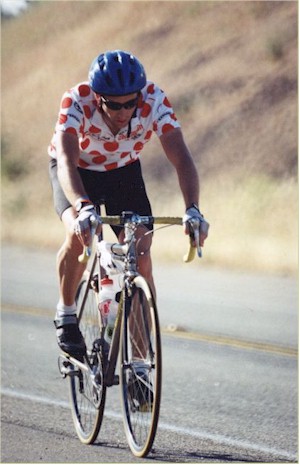People that know me know I’m a big fan of cycling. Here’s a picture of me in the Tour de France King of the Mountain jersey in 2000.

Pretty cool, huh? Context is important though, because that is a replica jersey bought in Verdun, France in 1993 (another time living in Luxembourg …) when a stage finished there. This picture was during the 2000 AIDS Ride and I wore the jersey because it was the hilliest day.
Interestingly, in 1993 in Verdun, some brash 21 year old American in the US champion’s Stars and Stripes jersey won his first ever stage of the Tour de France. His name was Lance Armstrong. I was so excited, an avid cyclist and American with an American winning the stage. Then he had his post-race interview, and it was unpolished and rude, and I was embarrassed. From that day, I had a love/hate relationship with him.
Watch this long video with Phil Liggett and Paul Sherwen, and look at the lineup of dopers! There is also a bit of a Verdun history lesson as well.
Lance didn’t win the Tour that year, and he wasn’t considered a GC rider at that time, but his time would come. His post race interview with Paul was pretty calculated. Lance certainly understood cycling even early in his career as that same year he went on to win the World Championship.
We have tickets to the Men’s Road Cycling event, which ends at Fuji International Speedway (the Japanese site is much more interesting). The course takes the cyclists from Tokyo, over some mountains (Doshi Road / Yamabushi Tunnel), over the 1451 m (4760 ft) Fuji Sanroku, a pass through the speedway, a run around Lake Yamanakako, back through the speedway, then onto the very steep Mikuni Pass followed by the Kagosaka pass, before descending and returning to the speedway for the finish. Cycling is a hard sport to watch, and probably best enjoyed watching the highlights. Flag to flag coverage can get a little boring. I’m not sure what the experience will be at the Olympics, but I am hoping they have lots of big screens so we can watch how the race unfolds. Otherwise we’ll just be sitting in the hot July weather, roasting until the leader or leaders approach the finish. There’s no way though that I wouldn’t try to be there. In my fandom, I’ve ridden the 1984 Olympic course in Mission Viejo.
Note that the route to Fuji Sanroku takes you on the roads that will get you to the Yamanashi 5th Station for climbing Mt. Fuji. Here’s my adventure from that starting point back in 2009. If you are following this blog, the Mt Fuji story is definitely worth reading.
The course and the profile for Tokyo 2020 are below.

People unfamiliar with cycling think it is an individual sport, but really it is a team sport. Typically a rider is designated as the team leader, and all the other cyclists in some form or another protect that leader physically and tactically throughout the race. That’s why it is important for nations to have the largest number of qualifiers possible. The maximum number is five, and unfortunately the US only has two. There are a total of 130 riders in the men’s event. Here’s the complete list of rider allocation per country. It is too long to list here.
Countries with five riders are:
Belgium
Colombia
Spain
France
Italy
Netherlands
Countries with four riders are:
Australia
Denmark
Great Britain
Germany
Norway
Slovenia
Switzerland
The qualifications are based on that country’s points according to the international governing body (UC).
The US determines its team either through an automated spot through meeting certain criteria, or by a selection committee.
Although I don’t have tickets to the women’s event, I’ll cover that separately as there are differences between the men’s and women’s events, and the US women are performing much better on the world stage than the US men.
